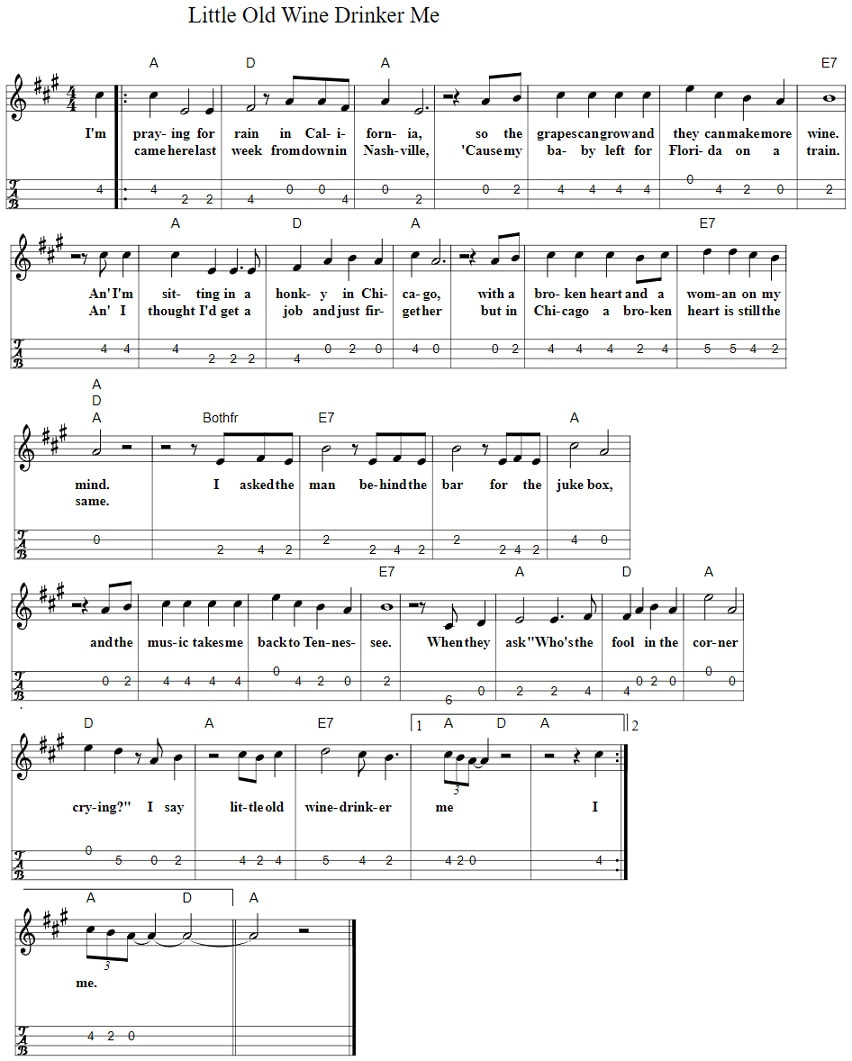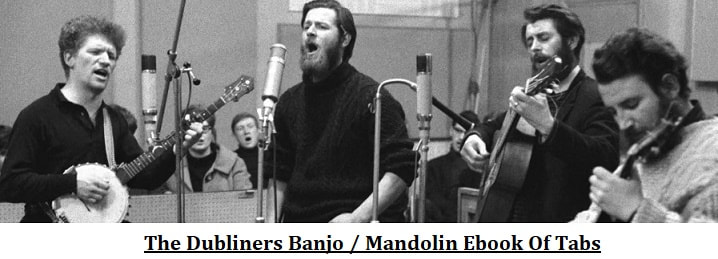Little Old Wine Drinker Me Mandolin Tab
Little Old Wine Drinker Me Mandolin Tab With Chords In The Key Of A Major. Made Famous By Dean Martin
The song 'Little Old Wine Drinker Me' was released in 1966 and quickly became a hit, reaching number 9 on the Billboard Hot 100 chart. Written by Dick Jennings and Hank Mills, the song was recorded by Dean Martin and has since been covered by numerous artists, cementing its place in popular culture. Despite its lighthearted and catchy melody, the lyrics of 'Little Old Wine Drinker Me' explore deeper themes of loneliness, escapism, and the struggle to find purpose in life.
At first listen, 'Little Old Wine Drinker Me' may seem like a cheerful and upbeat tune about enjoying a glass of wine with friends. However, a closer examination of the lyrics reveals a much more profound message. The song is narrated by a middle-aged man who has turned to alcohol as a means of coping with his unfulfilling life. He sings about his daily routine of working hard and coming home to a glass of wine, seeking temporary relief from his mundane existence. The line 'I'm praying for the day when I'll be on my way to heaven' hints at his underlying feelings of despair and longing for something more.
The central theme of the song is the protagonist's struggle with loneliness and isolation. He sings about how he is 'just a lonely soul' and how he 'can't even find a buddy to share his misery.' These lyrics paint a picture of a man who is surrounded by people, yet still feels alone. This could be a reflection of the societal pressures of the time, where men were expected to be strong and stoic, and vulnerability was seen as a weakness. The protagonist turns to alcohol as a way to numb his feelings of loneliness, highlighting the dangers of using substances as a coping mechanism.
The use of wine as a symbol for escapism is also prevalent in the song. The line 'I'm drowning my troubles till the bubbles disappear' suggests that the protagonist is using alcohol to escape his problems temporarily. He is aware that his drinking is not a long-term solution, but it provides him with a momentary escape from his reality. This is a common theme in many songs, where alcohol is portrayed as a means of forgetting one's troubles, even if only for a short while.
The title of the song, 'Little Old Wine Drinker Me,' also speaks to the idea of aging and the fear of losing one's youth. The use of the word 'little' conveys a sense of diminishment and further emphasizes the protagonist's feelings of insignificance and lack of purpose. The line 'I've got a lot of memories that I'd rather keep' suggests that the protagonist is holding onto the past, perhaps longing for the carefree days of his youth. This adds another layer to the song, exploring the theme of nostalgia and the fear of growing old.
The music of 'Little Old Wine Drinker Me' also adds to the overall mood and message of the song. The upbeat and lively melody contrasts with the somber lyrics, creating a sense of irony. This juxtaposition is deliberate and serves to highlight the protagonist's internal struggle between his desire for escapism and his realization that it is only temporary.
The popularity of 'Little Old Wine Drinker Me' is a testament to its universal themes and relatable message. It has been covered by artists from various genres, from country to pop, and has remained relevant even decades after its release. The song speaks to the human experience of searching for meaning and purpose in life, and the struggles we face along the way.
In conclusion, 'Little Old Wine Drinker Me' is much more than just a catchy tune about enjoying a glass of wine. Through its lyrics and music, the song delves into deeper themes of loneliness, escapism, and the fear of growing old. It serves as a reminder that we all have our struggles and that sometimes, we turn to unhealthy coping mechanisms in an attempt to find temporary relief. The enduring popularity of this song is a testament to its timeless message, making it a classic in the world of music.
At first listen, 'Little Old Wine Drinker Me' may seem like a cheerful and upbeat tune about enjoying a glass of wine with friends. However, a closer examination of the lyrics reveals a much more profound message. The song is narrated by a middle-aged man who has turned to alcohol as a means of coping with his unfulfilling life. He sings about his daily routine of working hard and coming home to a glass of wine, seeking temporary relief from his mundane existence. The line 'I'm praying for the day when I'll be on my way to heaven' hints at his underlying feelings of despair and longing for something more.
The central theme of the song is the protagonist's struggle with loneliness and isolation. He sings about how he is 'just a lonely soul' and how he 'can't even find a buddy to share his misery.' These lyrics paint a picture of a man who is surrounded by people, yet still feels alone. This could be a reflection of the societal pressures of the time, where men were expected to be strong and stoic, and vulnerability was seen as a weakness. The protagonist turns to alcohol as a way to numb his feelings of loneliness, highlighting the dangers of using substances as a coping mechanism.
The use of wine as a symbol for escapism is also prevalent in the song. The line 'I'm drowning my troubles till the bubbles disappear' suggests that the protagonist is using alcohol to escape his problems temporarily. He is aware that his drinking is not a long-term solution, but it provides him with a momentary escape from his reality. This is a common theme in many songs, where alcohol is portrayed as a means of forgetting one's troubles, even if only for a short while.
The title of the song, 'Little Old Wine Drinker Me,' also speaks to the idea of aging and the fear of losing one's youth. The use of the word 'little' conveys a sense of diminishment and further emphasizes the protagonist's feelings of insignificance and lack of purpose. The line 'I've got a lot of memories that I'd rather keep' suggests that the protagonist is holding onto the past, perhaps longing for the carefree days of his youth. This adds another layer to the song, exploring the theme of nostalgia and the fear of growing old.
The music of 'Little Old Wine Drinker Me' also adds to the overall mood and message of the song. The upbeat and lively melody contrasts with the somber lyrics, creating a sense of irony. This juxtaposition is deliberate and serves to highlight the protagonist's internal struggle between his desire for escapism and his realization that it is only temporary.
The popularity of 'Little Old Wine Drinker Me' is a testament to its universal themes and relatable message. It has been covered by artists from various genres, from country to pop, and has remained relevant even decades after its release. The song speaks to the human experience of searching for meaning and purpose in life, and the struggles we face along the way.
In conclusion, 'Little Old Wine Drinker Me' is much more than just a catchy tune about enjoying a glass of wine. Through its lyrics and music, the song delves into deeper themes of loneliness, escapism, and the fear of growing old. It serves as a reminder that we all have our struggles and that sometimes, we turn to unhealthy coping mechanisms in an attempt to find temporary relief. The enduring popularity of this song is a testament to its timeless message, making it a classic in the world of music.
Little old wine drinker me Bouzouki tab in GDAD Tuning
Introduction:
Sheet music is a written or printed form of musical notation used to represent music. It is an essential tool for musicians to read and interpret music accurately. One of the most commonly used keys in sheet music is the key of A Major. This key has a rich history and is still widely used in various genres of music. In this thesis, we will explore the key of A Major in depth, its history, characteristics, and its significance in music.
History of A Major:
The key of A Major has its origins in the early Baroque period, around the 17th century. It was one of the most popular keys used by composers during this time, alongside its relative minor, F# minor. One of the earliest known compositions in A Major is Johann Sebastian Bach's Brandenburg Concerto No. 5, written in 1721. This key continued to gain popularity in the Classical and Romantic periods, with notable compositions such as Mozart's Piano Sonata No. 11 and Beethoven's Symphony No. 7. In the 20th century, A Major remained a popular key in jazz, blues, and rock music, with songs like 'Sweet Child O' Mine' by Guns N' Roses and 'Imagine' by John Lennon.
Characteristics of A Major:
A Major is known as a major key, which means that it has a happy and uplifting sound. It is also part of the A major scale, which consists of the notes A, B, C#, D, E, F#, and G#. This scale has a unique pattern of whole and half steps, which gives A Major its distinct sound. The root note, A, is the starting and ending note in this key, making it the most important note in any composition in A Major. The key signature of A Major has three sharps, F#, C#, and G#, which gives it a bright and cheerful sound. This key is also closely related to its relative minor, F# minor, which shares the same key signature.
Significance in Music:
The key of A Major has a significant role in music, both historically and in contemporary times. As mentioned earlier, it was widely used by composers in the Baroque, Classical, and Romantic periods. Its bright and cheerful sound made it a popular choice for compositions with a happy or triumphant theme. In modern times, A Major is still used in various genres of music, including pop, rock, and country. Its uplifting sound is often associated with love, joy, and happiness, making it a popular key for love songs and ballads.
Sheet Music in A Major:
The use of sheet music in A Major has evolved over the years, with advancements in technology and music notation. In the past, sheet music was handwritten, making it a tedious and time-consuming process. With the invention of printing presses, sheet music became more accessible and widely available. In modern times, sheet music is often created using computer software, making it easier to edit, share, and distribute. A Major is also a popular key for beginner musicians, as it is relatively easy to play on various instruments such as piano, guitar, and violin.
Conclusion:
In conclusion, the key of A Major has a rich history and is still widely used in music today. Its bright and cheerful sound, along with its significance in various genres, makes it an essential key for musicians. The use of sheet music in A Major has evolved over the years, making it more accessible and easier to create. As music continues to evolve, the key of A Major will undoubtedly continue to be a prominent and beloved key in music.
Sheet music is a written or printed form of musical notation used to represent music. It is an essential tool for musicians to read and interpret music accurately. One of the most commonly used keys in sheet music is the key of A Major. This key has a rich history and is still widely used in various genres of music. In this thesis, we will explore the key of A Major in depth, its history, characteristics, and its significance in music.
History of A Major:
The key of A Major has its origins in the early Baroque period, around the 17th century. It was one of the most popular keys used by composers during this time, alongside its relative minor, F# minor. One of the earliest known compositions in A Major is Johann Sebastian Bach's Brandenburg Concerto No. 5, written in 1721. This key continued to gain popularity in the Classical and Romantic periods, with notable compositions such as Mozart's Piano Sonata No. 11 and Beethoven's Symphony No. 7. In the 20th century, A Major remained a popular key in jazz, blues, and rock music, with songs like 'Sweet Child O' Mine' by Guns N' Roses and 'Imagine' by John Lennon.
Characteristics of A Major:
A Major is known as a major key, which means that it has a happy and uplifting sound. It is also part of the A major scale, which consists of the notes A, B, C#, D, E, F#, and G#. This scale has a unique pattern of whole and half steps, which gives A Major its distinct sound. The root note, A, is the starting and ending note in this key, making it the most important note in any composition in A Major. The key signature of A Major has three sharps, F#, C#, and G#, which gives it a bright and cheerful sound. This key is also closely related to its relative minor, F# minor, which shares the same key signature.
Significance in Music:
The key of A Major has a significant role in music, both historically and in contemporary times. As mentioned earlier, it was widely used by composers in the Baroque, Classical, and Romantic periods. Its bright and cheerful sound made it a popular choice for compositions with a happy or triumphant theme. In modern times, A Major is still used in various genres of music, including pop, rock, and country. Its uplifting sound is often associated with love, joy, and happiness, making it a popular key for love songs and ballads.
Sheet Music in A Major:
The use of sheet music in A Major has evolved over the years, with advancements in technology and music notation. In the past, sheet music was handwritten, making it a tedious and time-consuming process. With the invention of printing presses, sheet music became more accessible and widely available. In modern times, sheet music is often created using computer software, making it easier to edit, share, and distribute. A Major is also a popular key for beginner musicians, as it is relatively easy to play on various instruments such as piano, guitar, and violin.
Conclusion:
In conclusion, the key of A Major has a rich history and is still widely used in music today. Its bright and cheerful sound, along with its significance in various genres, makes it an essential key for musicians. The use of sheet music in A Major has evolved over the years, making it more accessible and easier to create. As music continues to evolve, the key of A Major will undoubtedly continue to be a prominent and beloved key in music.




